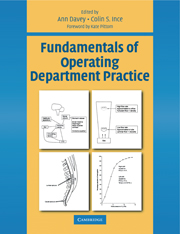Book contents
- Frontmatter
- Contents
- Contributors
- Preface
- Foreword
- Acknowledgements
- Introduction
- Chapter 1 The operating department practitioner, the patient and the law
- Chapter 2 Aspects of health and safety in the operating department
- Chapter 3 The caring practitioner
- Chapter 4 Strategies for infection control in the operating department
- Chapter 5 Sterilization, decontamination and the surgical field
- Chapter 6 The fundamentals of cardiovascular physiology
- Chapter 7 Fundamentals of respiratory physiology
- Chapter 8 Scientific principles in relation to the anaesthetic machine
- Chapter 9 Fundamentals of artificial ventilation of the lung
- Chapter 10 Scientific principles in relation to monitoring equipment
- Chapter 11 Scientific principles in relation to endoscopic, laser and radiological equipment
- Chapter 12 Pharmacological principles of drug administration
- Chapter 13 The pharmacology of drugs used in general anaesthesia
- Chapter 14 The local anaesthetic drugs - does the ideal agent exist?
- Chapter 15 The safe positioning of patients for surgery
- Chapter 16 Principles involved in the management and use of equipment
- Chapter 17 Understanding suture materials
- Chapter 18 Fundamentals ofpaediatric surgery and anaesthesia
- Chapter 19 Fundamentals of hyperthermia and hypothermia
- Chapter 20 Fundamentals of fluid and electrolyte balance during surgery
- Chapter 21 The physiology of blood and its administration
- Chapter 22 Fundamentals of pain relief
- Chapter 23 Fundamentals of dressings and drains in relation to wound healing
- Chapter 24 The recovery of patients from anaesthesia and surgery
- Chapter 25 Fundamentals of emergency and obstetric anaesthesia
- Chapter 26 Identification and management of anaesthetic emergencies
- Chapter 27 The fundamentals of emergency resuscitation
- Appendixes
- Index
Chapter 15 - The safe positioning of patients for surgery
Published online by Cambridge University Press: 05 October 2015
- Frontmatter
- Contents
- Contributors
- Preface
- Foreword
- Acknowledgements
- Introduction
- Chapter 1 The operating department practitioner, the patient and the law
- Chapter 2 Aspects of health and safety in the operating department
- Chapter 3 The caring practitioner
- Chapter 4 Strategies for infection control in the operating department
- Chapter 5 Sterilization, decontamination and the surgical field
- Chapter 6 The fundamentals of cardiovascular physiology
- Chapter 7 Fundamentals of respiratory physiology
- Chapter 8 Scientific principles in relation to the anaesthetic machine
- Chapter 9 Fundamentals of artificial ventilation of the lung
- Chapter 10 Scientific principles in relation to monitoring equipment
- Chapter 11 Scientific principles in relation to endoscopic, laser and radiological equipment
- Chapter 12 Pharmacological principles of drug administration
- Chapter 13 The pharmacology of drugs used in general anaesthesia
- Chapter 14 The local anaesthetic drugs - does the ideal agent exist?
- Chapter 15 The safe positioning of patients for surgery
- Chapter 16 Principles involved in the management and use of equipment
- Chapter 17 Understanding suture materials
- Chapter 18 Fundamentals ofpaediatric surgery and anaesthesia
- Chapter 19 Fundamentals of hyperthermia and hypothermia
- Chapter 20 Fundamentals of fluid and electrolyte balance during surgery
- Chapter 21 The physiology of blood and its administration
- Chapter 22 Fundamentals of pain relief
- Chapter 23 Fundamentals of dressings and drains in relation to wound healing
- Chapter 24 The recovery of patients from anaesthesia and surgery
- Chapter 25 Fundamentals of emergency and obstetric anaesthesia
- Chapter 26 Identification and management of anaesthetic emergencies
- Chapter 27 The fundamentals of emergency resuscitation
- Appendixes
- Index
Summary
INTRODUCTION
Prior to the introduction of anaesthesia in the 19th century, patients were positioned for surgery on their beds, wooden tables, an operating chair or any hard surface that was available. They were then tied down or held in position by the surgeon's assistants so that surgery could be quickly completed but there was little attention to the rights or dignity of the patient.
Good practice in patient positioning is an essential factor in promoting and safeguarding the well-being of patients in the perioperative period and is achieved through the collaboration of the multidisciplinary health-care team. The acquisition of knowledge and the development of skills, effective communication and team work all contribute to the prevention of complications, avoidance of accidents and the reduction of risks associated with this task. Appropriate and well-designed training programmes play a vital role in this process but clinical practice must also be updated and reviewed regularly in order to maintain currency in the constantly developing fields of anaesthesia and surgery. The resultant quality service, which meets patients' expectations, should be measured against processes such as risk management and clinical audit.
Ideally, preoperative assessment should identify individual needs and potential problems which, recorded in the plan of care and communicated verbally, will focus the team's action plan. Positioning is essentially a team activity but requires an experienced coordinator and this role is most naturally and frequently filled by the anaesthetist. However, if more complicated arrangements such as those involving an operating microscope are indicated, it is usual for the surgeon also to be involved.
Lifting and handling manoeuvres should never be attempted unless there are sufficient personnel present, possessing both the skills and strength required for safe practice.
THE AIMS OF SAFE PATIENT POSITIONING
Warren (1983), and Ignatavicius and Bayne (1991) have described the principal aims that are designed to achieve:
Physiological alignment.
Minimal interference with circulation.
Protection of skeletal and neuromuscular structures.
Optimum exposure to operative and anaesthetic sites.
Patient comfort and safety.
Patient dignity.
Stability and security in position.
- Type
- Chapter
- Information
- Fundamentals of Operating Department Practice , pp. 167 - 176Publisher: Cambridge University PressPrint publication year: 1999

